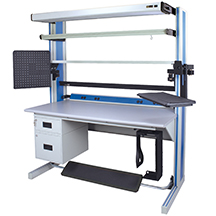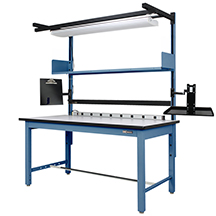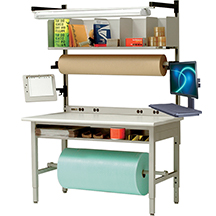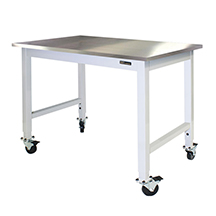The Science behind Ergonomic Design
06/16/2017
Consider our friend and loyal coworker, Assembly Jane. She’s been a hard worker for an assembly company for a while now, but recently, she’s noticed a pain in her hand. At first, she didn’t think much of it, but now it’s starting to affect her work. When she reaches for a tool on the top shelf, or when she picks something out of the parts cup that’s just out of arm’s reach, she’s in immense pain. These are common symptoms of musculoskeletal disorders, which are incredibly prevalent in the workplace. They’re usually due to an absence of ergonomics in the design process and actually easily preventable with the right planning.
The first step in designing an ergonomic workspace is understanding that the work must fit the worker; the worker shouldn’t be forced into fitting the job. This can be accomplished most effectively by planning ahead in the design process. When choosing a work bench, a desk, or any work space, it’s so important to envision the employee working there; consider what tasks she will be doing, the range of motion needed to accomplish these tasks, what necessary tools should be easily accessible, etc. By visualizing the worker at the station and preparing for all circumstances in the design stage, the end result will be much more successful.
While crafting the work station itself, ergonomic standards must be considered. First and foremost is the worksurface height. This aspect, like the large majority of ergonomics, depends on the user’s unique physical build in relation to the type of work being done on the worksurface. However, in order to implement the perfect surface height, the designer must take into account the working height. It’s important to note the difference between surface height – where the table top is – and working height – where the task at hand is being worked on. For instance, if Assembly Jane is assembling larger products, the surface height should be lower than Assembly Joe’s, who works on fine detail assembly, in order to accommodate for their respective working heights. The best way to account for all work tasks, statures, and variability between them is through adjustable workstations, like the Standard Pro Series from IAC Industries. Not only will it adjust to fit the worker, it can adjust to fit the task. In order to adapt to everyone’s needs, Back Designs, Inc. recommends adjustable worksurface heights should have a range from 22 to 33 inches off the ground.
Another variable in surface height depends on whether the user is sitting, standing, or both. It’s no secret that sitting all day is bad for you. It’s also true that standing all day is not sensible and actually has its own health drawbacks like fatigue. Having a sit and stand workstation allows a range of movement that is vital to health in the workplace. For this type of workstation, the optimal range should be between 22 and 47 inches in height. More importantly though, the height is dependent on the work and the worker, and it should provide a good base for other workspace features to create an overall ergonomic environment.
On that note, it’s important to understand that all aspects of the workspace must be considered in the design stages; it’s not just the workstation that needs to be ergonomic. The seating, the lighting, the tools, and more should be designed in a comfortable and safe way to maximize productivity and efficiency. For example, the seating in conjunction with the workbench should allow proper angles for legs, arms, wrists, and the back. The lighting should prevent glares, reflections, and shadows so as to prevent eye fatigue and headaches. The tools should be easy to handle and avoid too much force or repetitive motions. Moreover, they should be easily accessible, preferably within arm’s reach, and should not require awkward or uncomfortable body movements. Ultimately, the ergonomics of a workstation is going to be different for all types of work. Sitting, standing, sitting and standing, even mobile stations, and regular old office desks are all going to have different recommended designs to fit the worker, but in the end, it’s essential to recognize the role ergonomics plays in these designs and, at the end of the day, the success of a company.
To learn more about why ergonomics is worth investing in, check out this page.
 Buy Online Now!
Buy Online Now!
 Buy Online Now!
Buy Online Now!










